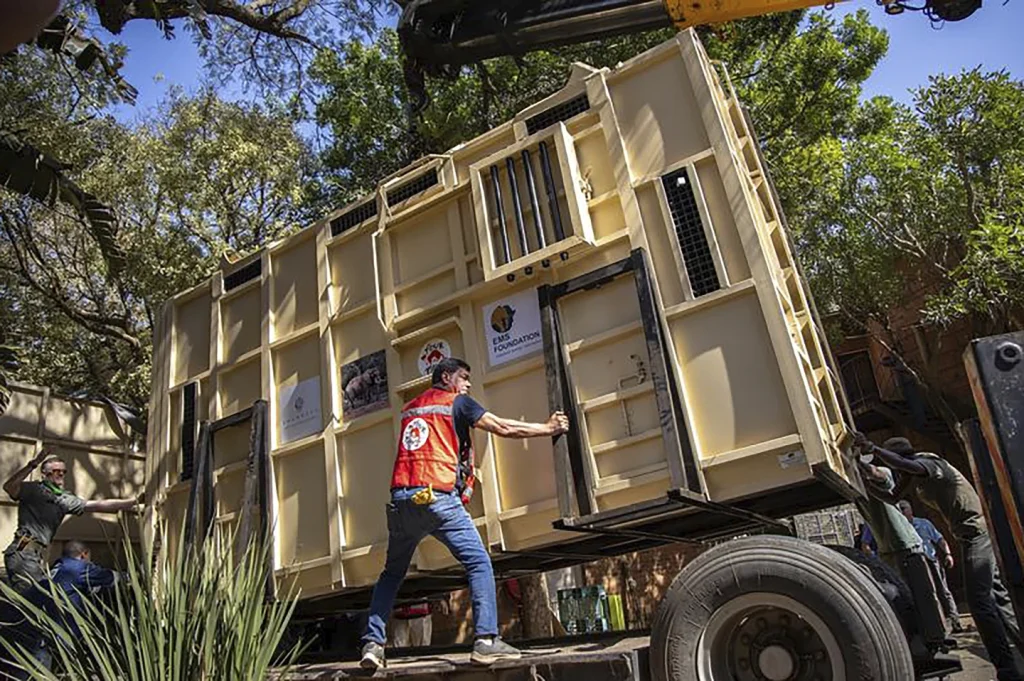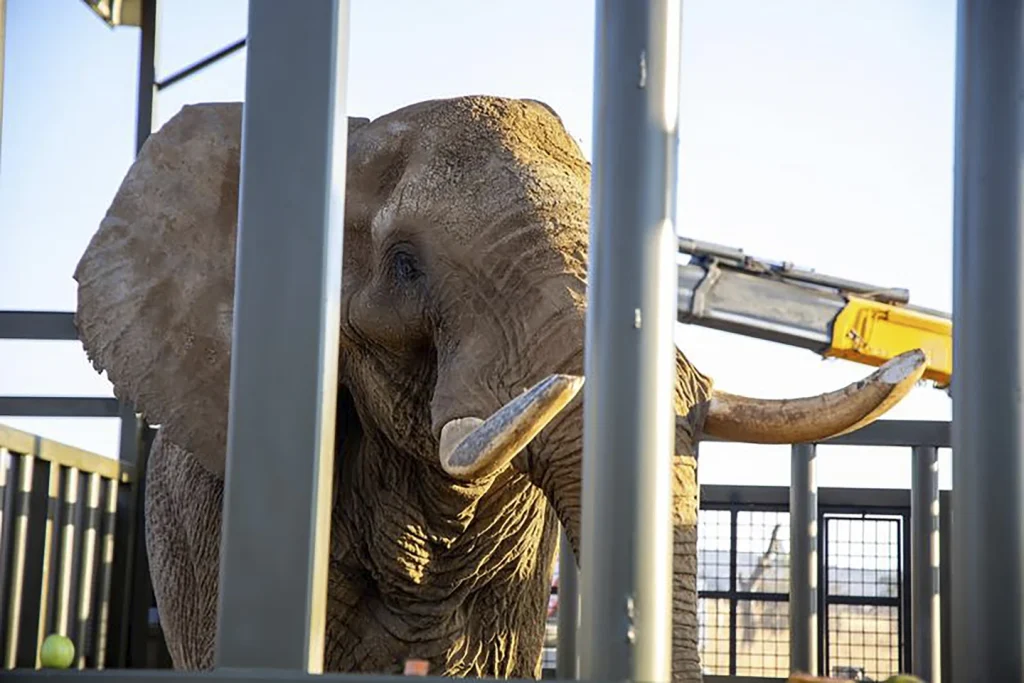In recent years, the field of wildlife conservation has witnessed remarkable acts of compassion and dedication, particularly in the niche but essential business of relocating elephants.
Among the esteemed professionals in this field is Dr. Amir Khalil, an Egyptian veterinarian whose considerable expertise has garnered him a reputation as a leading figure in elephant relocation.
His notable accomplishments include one of the most talked-about elephant rescuations in history: the case of Kaavan, an Asian elephant who was deemed the “world’s loneliest elephant.” This landmark operation not only highlighted the potential for changed lives through determined conservation efforts but also ushered in a ripple of hope for other elephants suffering from the detrimental effects of captivity.
The subsequent task that lay ahead for Dr. Khalil and his dedicated team was the relocation of Charley, an aging African elephant held captive in a zoo in South Africa, whose circumstances alike drew national and international attention.
Charley’s life is a poignant narrative of captivity, loss, and the slow erosion of joy that elephants experience when separated from their natural habitats and social structures.
Originating from western Zimbabwe in the 1980s, Charley was taken from his herd as a young calf and forced to endure an existence that included 16 years in a circus followed by 23 years as a prime attraction at Pretoria’s National Zoological Garden.
By the time he reached the age of 42, he had spent an astonishing 40 years in confinement, outliving all his companions.
The profound impact that such a life has had on Charley became acutely clear after the loss of his partner, Landa, in 2020.
His emotional distress manifested in visible signs of unhappiness within his enclosure, prompting zoo officials to rightly determine that it was time for him to be “retired” to a more appropriate habitat that would enrich his twilight years.
The ethical implications surrounding elephant relocation are profound. Elephants are not merely animals; they are sentient beings exhibiting complex emotions, social structures, and cognitive abilities.
When we consider the success of a relocation effort, it is vital to evaluate the psychological and physical well-being of the animal involved. In Charley’s case, wildlife experts asserted that his well-being was inversely correlated with his prolonged captivity.
This raises critical questions about our responsibilities towards captive wildlife and our capacity to restore their dignity and natural behaviors.
As Khalil aptly noted, after decades of public enjoyment derived from Charley’s confinement, it was surely his turn to experience the freedoms of an elephant’s life.
Dr. Khalil’s methodology for relocating elephants stands as a testament to the ethical and thoughtful approaches necessary for such formidable tasks.
His refusal to employ tranquilizers, which could prove detrimental given the sheer size of a four-ton elephant, reflects a profound understanding of both the physical and psychological vulnerabilities of these majestic creatures.
Instead, his approach is grounded in a commitment to earning the trust of the animal through gradual and positive reinforcement—a method exemplified in his interactions with Charley over two years.
This included hands-on training where Charley was encouraged to approach and respond positively to a “training wall,” ultimately leading to successful crate training that culminated in Charley entering the transport container without excessive stress or fear.
The complexities involved in relocating an elephant are multifaceted. The logistics of safely moving such a large animal, while ensuring its comfort and emotional readiness, require immense preparation.
Khalil’s team, which included fellow veterinarians Dr. Marina Ivanova and Dr. Frank Göritz, displayed both compassion and expertise during what they anticipated would be a lengthy acclimatization process.
However, in a remarkable turn of events, Charley embraced this new training regimen more quickly than expected, entering the transport container within a short span of just two weeks.
Having successfully demonstrated his willingness and readiness to move, Charley’s journey to a large private game reserve approximately 200 kilometers away became a historical moment in the realm of wildlife conservation.
The move signifies more than just a change in physical location; it symbolizes the restoration of autonomy and the potential for social integration within a herd, an opportunity for Charley to forge new bonds and to heal from the emotional trauma inflicted by decades of captivity.
In a well-structured natural environment, Charley is now granted the potential for a fuller, richer life. He will have the chance to interact with other elephants, showcasing the social dynamics inherent to their species.
Research has consistently shown that elephants in the wild thrive within complex social structures, and the denouement of Charley’s relocation embodies the essence of what conservationists strive to achieve: the liberation of captive animals and the restoration of their dignity as they transition into environments where they can engage in their innate behaviors.
In a poignant representation of wildlife rehabilitation, the recent introduction of Charley, an aged elephant, to the Shambala private game reserve signifies not merely a physical relocation, but a profound opportunity for rejuvenation and reintegration into a more natural environment.
After an arduous hours-long journey in the back of a truck, Charley was welcomed to a place that promises to be his new sanctuary, albeit in a transitional holding area separate from the main park for the initial weeks, a necessary measure to allow this venerable creature to acclimatize to such a monumental shift.
The dedicated team overseeing his care has thoughtfully implemented this approach, recognizing the need to ease the resettlement of an elderly elephant who has spent the past four decades in captivity.
The Shambala reserve, endowed with vast expanses of land and populated by wild elephant herds, offers a promising prospect for Charley to eventually rejoin his kind, thereby reiterating the rare yet commendable initiative of reintroducing captive elephants into their natural habitats—a feat applauded by Khalil, who commended the cooperation of South Africa’s environmental authorities and the Pretoria zoo for facilitating this groundbreaking endeavor.
“It’s a laudable message from South Africa that even an old elephant deserves a new chance,” Khalil articulated, emphasizing the social and intelligent nature of elephants and the potential for them to reclaim their wild instincts.
Describing Charley’s prior existence as akin to watching the same film in solitude day after day, Khalil illuminated the emotional complexities of captivity, where the innate mischievousness and playfulness of elephants often remain stifled.
In his new home, Charley will have the liberty to engage in natural behaviors such as mud bathing, exploring the bush, and ultimately rediscovering the essence of being a wild elephant.
Encouragingly, reports indicate that even from his holding pen, Charley is already attempting to establish contact with the park’s resident elephant population through deep rumbles that resonate up to three miles away—an infant step towards reshaping his identity.
Ivanova’s delight in hearing his rumbles underscores the optimism surrounding Charley’s rehabilitation; she expressed a commitment to nurturing him back into the wild, reinforcing the belief in the transformative power of nature as an antidote to the confines of captivity.
The story of Charley’s relocation is emblematic of a growing recognition of the ethical imperatives of wildlife rescue and conservation.

Dr. Amir Khalil and his team’s commitment to not only undertake the logistical challenges but to prioritize the psychological well-being of the elephant, resonates deeply within the broader discourse on animal welfare.
While the successful relocation of Charley provides an uplifting narrative, it also serves as a call to action for society to regard captive wildlife with the dignity they deserve.
In essence, Charley’s journey reminds us that in the larger narrative of human-animal relationships, we must strive to be compassionate stewards of the natural world—forever mindful of the elephants that need rescuing from unsatisfactory circumstances, and dedicated to ensuring they are afforded the chance to live fulfilling lives that resonate with their intrinsic nature.
